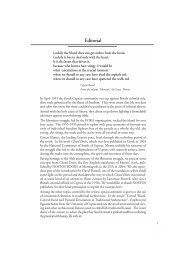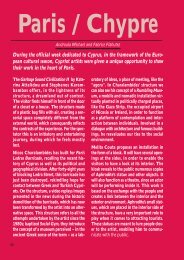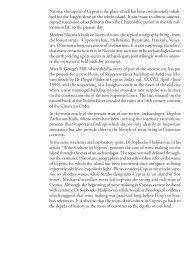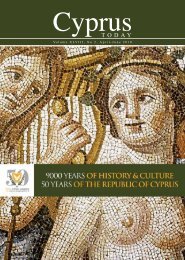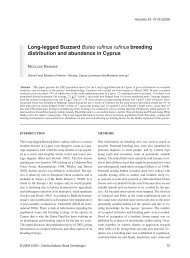Editorial
Editorial
Editorial
Create successful ePaper yourself
Turn your PDF publications into a flip-book with our unique Google optimized e-Paper software.
86<br />
The Terpandros Orchestra playing at Casteliotissa Hall.<br />
scales which were composed of tones and semitones<br />
(diatonic scales), there existed those which<br />
were composed of semitones and three-semitones<br />
(chromatic scales), and others composed<br />
of quarters of tones and two-toned intervals<br />
(henarmonic). The kind of intervals used<br />
by each scale is called genus. Each genus had<br />
different shades which were called colors. The<br />
fact that would seem strange to the ancient<br />
Greeks is that contemporary scales would sound<br />
disonal, having fallen victims of blending. Because<br />
of the fact that ancient scales were based on natural<br />
intervals in accordance with Pythagoras’s<br />
findings in the 6th century BC semitones and<br />
tones were not equal between them, with the<br />
result that it was difficult to transpose musical<br />
pieces (a fact that did not bother the ancient<br />
Greeks, since their melodies were mostly monodies).<br />
In the 16th AC century, western musicians sacrificed<br />
the melody of unequal musical intervals<br />
in order to gain complete freedom for the transportation<br />
(for the sake of polyphony), and comfort<br />
for the practical use of keyboard instruments.<br />
This was achieved with the equalization<br />
of the twelve semitones of the octave, in other<br />
words the equal temperament where semitones<br />
become equal, and fourths and fifths are allowed<br />
to become slightly imperfect. So a compromise<br />
was found between the laws of nature and the<br />
needs of art.<br />
At this point it should be stressed that ancient<br />
Greeks had a different concept of concord from<br />
our own. To them there were only four perfect<br />
concords: Unison, the eighth, the fifth and<br />
the fourth. A noticeable fact is that the ancient<br />
Greeks never considered the third as a concord<br />
interval, although it forms the basis of contemporary<br />
harmony. In fact Gavdentios calls<br />
it disonal as an intermediate step between<br />
concord and discord intervals.<br />
One can easily understand how ancient Greek<br />
music gave a variety of choices regarding the<br />
kind of intervals used (genuses, chroiai) and<br />
to the way that unites them (systems).<br />
So a composer could compose a piece and<br />
perform it differently if he wished to do so.<br />
He could change the scale (like today) with the<br />
selection of another tone transposing the piece.<br />
He could change the mode that is to do a modulation.<br />
Today this is also done mainly between<br />
Major and Minor scales. He could change the<br />
genus and chroia that is to do a complete change<br />
of the piece. Today this is not possible because<br />
melody uses only the diatonic scales. He<br />
could change the system from synimmeno (conjuct)<br />
to diazevgmeno (disjunct). That is to do<br />
a systematic change. Apart from the melody, he<br />
could also (like today) change the rhythm, speed<br />
and character of the piece by using the rest of<br />
the changes.<br />
It is obvious that where Western music was seeking<br />
beauty through polyphonic multiplication






